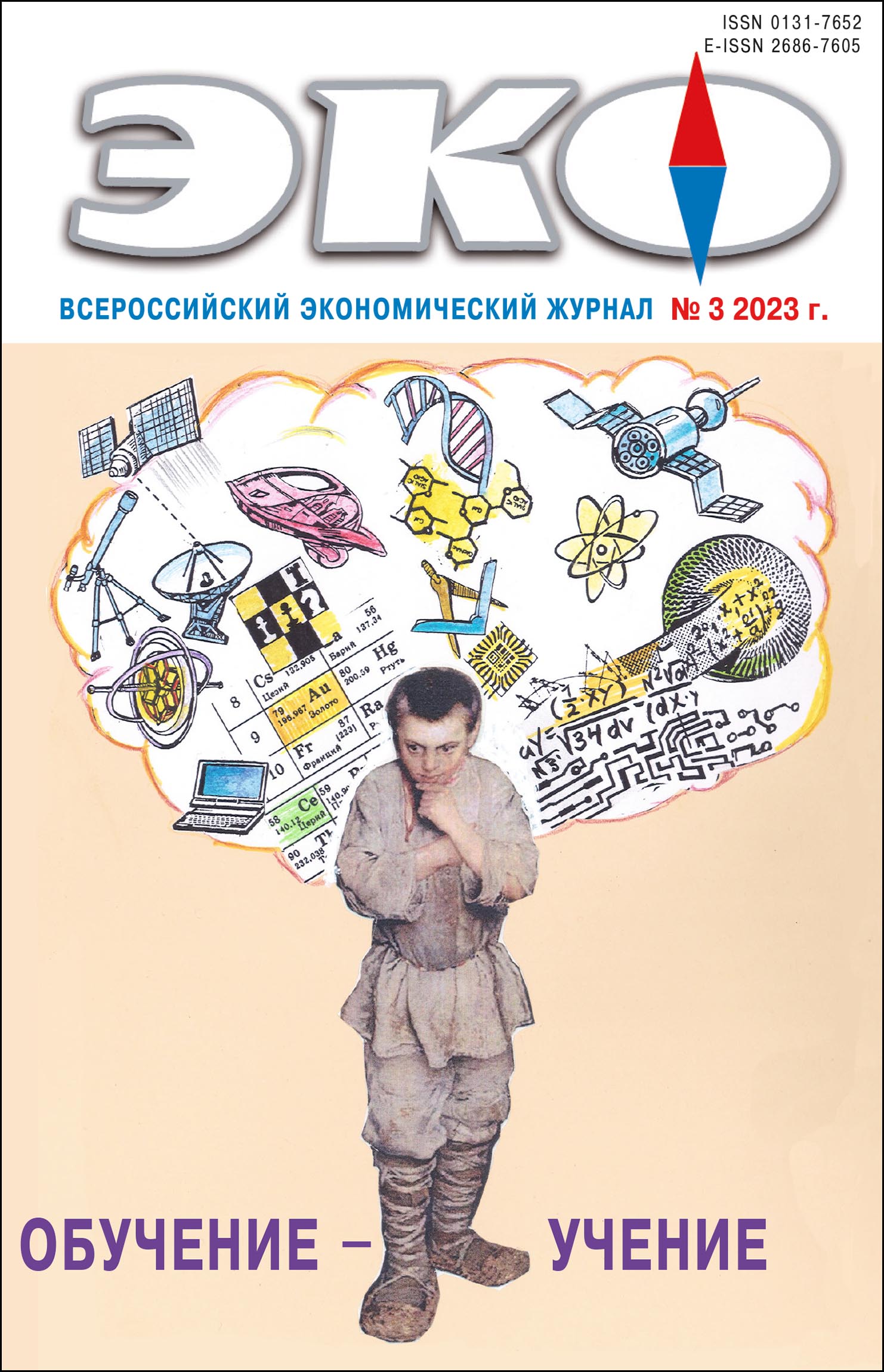Cover story: Lerning – Teaching
Published 2023-03-06
Keywords
- STEM education; human capital; interdisciplinary approach to education; tax incentives; tax benefits
How to Cite
1.
Tikhonova А, Malkova Ю. Development of the Stem-Education System in Russia and its Tax Incentives. ECO [Internet]. 2023 Mar. 6 [cited 2026 Jan. 20];53(3):27-46. Available from: https://ecotrends.ru/index.php/eco/article/view/4577
Abstract
The paper discusses the approaches to the implementation of STEM-education in higher education and the methods used for this purpose, including economic (tax) incentives. Particular emphasis is placed on the application of the E-STEM-education scheme, which includes, among other things, entrepreneurial practice. The examples of STEM-approach implementation in higher education described in the foreign literature show that the existing models of cooperation between educational organizations, scientific institutions and corporations are not always effective. Additional measures are required to develop this system in Russia. In particular, to solve the problems arising in the interaction of education of science and business, the authors propose to use a set of tax incentives, allowing them to cooperate effectively, while maintaining the property isolation and financial autonomy.References
- Жукова А. К. Современные проблемы правового регулирования и бухгалтерского учета совместной деятельности // Инновационное развитие экономики. 2017. № 6 (42). С. 284–291. URL: http://www.ineconomic.ru/sites//field_print_version/6–42–2017.pdf (дата обращения: 14.07.2022).
- Иванова А. В., Вылегжанина Е. В. Налоговое стимулирование инвестиций: понятие, принципы, задачи // Вектор экономики. 2021. № 8 (62). URL: http://www.vectoreconomy.ru/images/publications/2021/8/taxes/Ivanova_Vylegzhanina.pdf (дата обращения: 18.07.2022).
- Касымова Н. О. STEM-образование как научная новация// Актуальные вопросы образования и науки. 2022. № 1(73). С. 52–54 URL: https://www.elibrary.ru/download/elibrary_48198239_84518563.pdf (дата обращения: 14.07.2022).
- Краснова Г. А., Федотов А. В. STEM-образование как фактор национальной безопасности // Вестник российского университета дружбы народов. Серия: Информатизация образования. 2021. Т. 18. № 2. С. 137–151. DOI: 10.22363/2312–8631–2021–18–2–137–151
- Пансков В. Г. Новая амортизационная политика как инструмент налогового регулирования // Экономика и управление: проблемы, решения. 2021. Т. 4. № 4 (112). С. 35–41. DOI: 10.36871/ek.up.p.r.2021.04.04.007
- Рив Э. М. Потребность в STEM образовании: сейчас или никогда! // Современное технологическое образование. Сборник статей, докладов и материалов XXVII Международной научно-практической конференции. Москва, 2021. Ассоциация технических университетов. С. 34–57. URL: https://www.elibrary.ru/download/elibrary_47934526_77658975.pdf (дата обращения: 14.07.2022).
- Шабанова М. Р., Шумяцкий Р. И. Инвестиционный налоговый вычет как альтернатива амортизации // Финансы и управление. 2020. № 1. С. 103–113. DOI: 10.25136/2409–7802.2020.1.29570
- Almosova A., Burda M. C., Voigts S. Social Security Contributions and the Business Cycle // Journal of Macroeconomics. 2020. Vol. 65. DOI: https://doi.org/10.1016/j.jmacro.2020.103209
- Burušić J., Šimunović M., Šakić M. Technology-based activities at home and STEM school achievement: the moderating effects of student gender and parental education // Research in Science & Technological Education. 2021. Vol. 39. No. 1. P. 1–22. DOI: https://doi.org/10.1080/02635143.2019.1646717
- Caro D. H., Cortina K. S., Eccles J. S. Socioeconomic background, education, and labor force outcomes: evidence from a regional US sample // British Journal of Sociology of Education.2015. Vol. 36. No. 6. P. 934–957. DOI: https://doi.org/10.1080/01425692.2013.868784
- Eltanahy M., Forawi S., Mansour N. Incorporating Entrepreneurial Practices into STEM Education: Development of Interdisciplinary E-STEM Model in High School in the United Arab Emirates // Thinking Skills and Creativity. 2020а. Vol. 37. DOI: https://doi.org/10.1016/j.tsc.2020.100697
- Eltanahy M., Forawi S., Mansour N. STEM leaders’ and teachers’ views of the integration of the Entrepreneurial Practices into STEM Education in High School in the United Arab Emirates // Entrepreneurship Education (EEDU). 2020b. Vol. 3. No. 2. P. 133–149. DOI: https://doi.org/10.1007/s41959–020–00027–3
- Krug D., Shaw A. Reconceptualizing ST®E(A)M(S) education for teacher education // Canadian Journal of Science Mathematics and Technology Education. 2016. Vol. 16. No. 2. Р.183–200. DOI: https://doi.org/10.1080/14926156.2016.1166295
- Le L. T.B., Tran T. T., Tran N. H. Challenges to STEM education in Vietnamese high school contexts // Heliyon. 2021. Vol. 7. № 12. DOI: https://doi.org/10.1016/j.heliyon.2021.e08649
- Margot K. C., Kettler T. Teachers’ perception of STEM integration and education: a systematic literature review // Int. J. STEM Educ. 2019. Vol. 6. No.1. P. 1–16. DOI: https://doi.org/10.1186/s40594–018–0151–2
- Martins L., Veiga P. Do inequalities in parents’ education play an important role in PISA students’ mathematics achievement test score disparities? // Economics of Education Review. 2010. Vol. 29. No. 6. P. 1016–1033. DOI: https://doi.org/10.1016/j.econedurev.2010.05.001
- Miller J. D., Kimmel L. G. Pathways to a STEMM Profession // Peabody Journal of Education. 2012. Vol. 87. No. 1. P. 26–45. DOI: https://doi.org/10.1080/0161956X.2012.642274
- Nielsen I., Smyth R. Who bears the burden of employer compliance with social security contributions? Evidence from Chinese firm level data // China Economic Review. 2008. Vol. 19. No. 2. P. 230–244. DOI: https://doi.org/10.1016/j.chieco.2007.06.002
- Olssen M., Peters M. A. Neoliberalism, higher education and the knowledge economy: From the free market to knowledge capitalism // Journal of Education Policy. 2005. Vol. 20. No. 3. Р. 313–345. DOI: https://doi.org/10.1080/02680930500108718
- Pfeffer F. T. Growing Wealth Gaps in Education // Demography. 2008. Vol. 55. No. 3. P. 1033–1068. DOI: https://doi.org/10.1007/s13524–018–0666–7
- Reardon S. F. The widening academic achievement gap between the rich and the poor: New evidence and possible explanations // G. J. Duncan, R. J. Murnane (Eds.), Whither opportunity, Russell Sage. 2011. P. 91–116. DOI:10.4324/9780429499821–33
- Wiesner S., Horizonte B. The Development of Technicians as a Key Factor for a Sustainable Development of Renewable Energies Using an Adapted Education Method Based on the Successful German Dual Education (Duale Ausbildung) // Energy Procedia. 2014. Vol.57. P. 1034–1036. DOI: https://doi.org/10.1016/j.egypro.2014.10.069
- Xie Y., Fang M., Shauman K. STEM education // Annual Review of Sociology.2015. Vol. 41. P. 331–357. DOI: https://doi.org/10.1146/annurev-soc-071312–145659
- Ziol-Guest K.M., Lee K. T.H. Parent income–based gaps in schooling: Cross-cohort trends in the NLSYs and the PSID // AERA Open. 2016. Vol. 2. No. 2. DOI: https://doi.org/10.1177/2332858416645834

